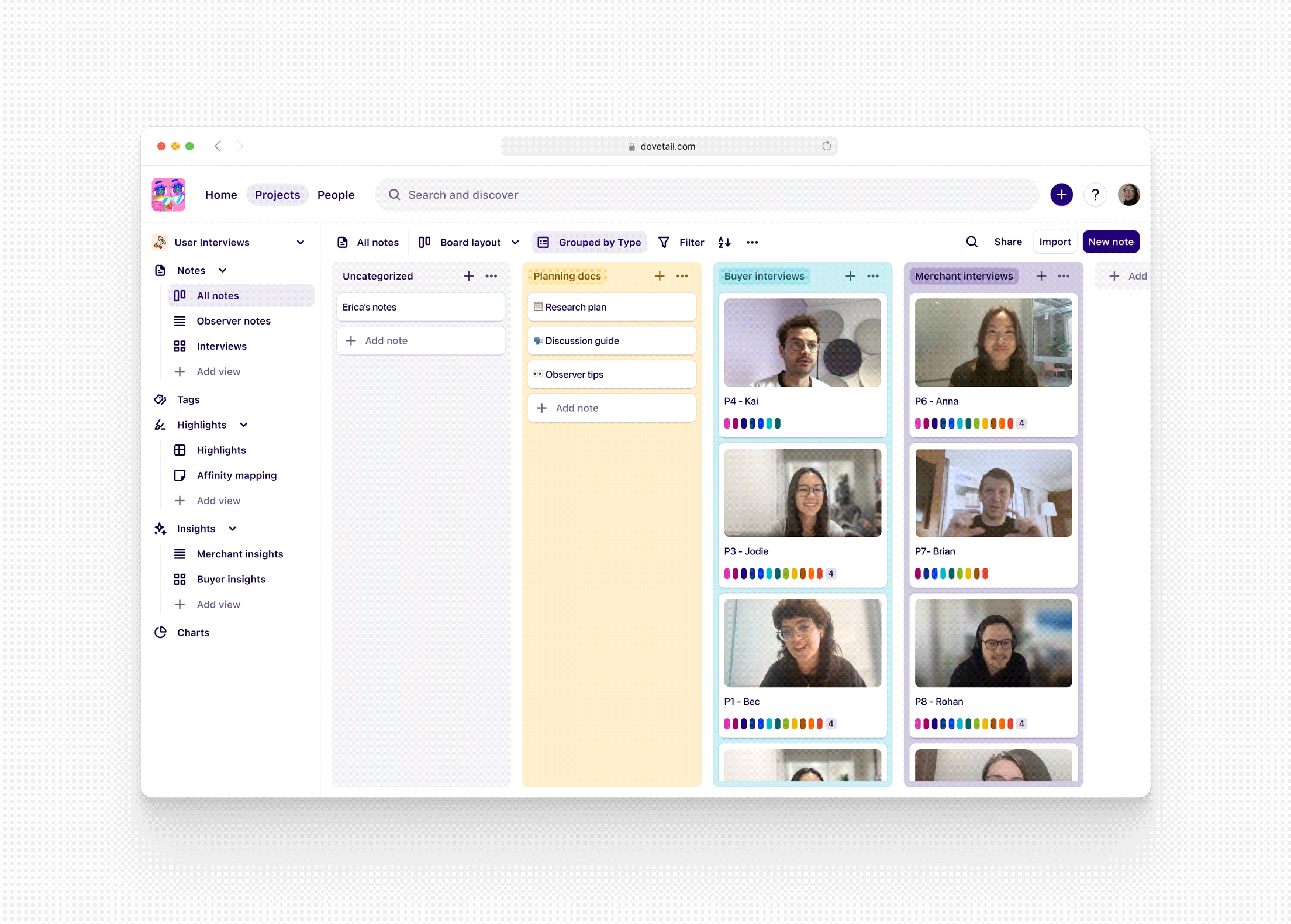Redesigning Projects in Dovetail
Timeline: 9 months | 2021-2022
Introduced relational databases and five new layouts to Dovetail projects, enabling flexible data synthesis and customizable research workflows.
The opportunity.
What does Dovetail do?
With Dovetail, researchers, designers, and product managers can store customer data in one place, analyze qualitative data to discover patterns and insights, and share research findings with the rest of their organization.
User problem
The current design of Dovetail's project structure is linear and rigid, offering a one-size-fits-all research process. This approach is limiting for users who have different research methodologies and require a more flexible structure. As a result, users are forced to either adhere to this approach, use Dovetail in conjunction with other tools to meet their needs, or, if the friction is high enough, simply not use Dovetail at all.
Existing project experience
Some quick context to understand Dovetail projects
Notes (previously named data)
Notes are your raw data (e.g., customer interviews, usability tests, support tickets etc.) from which you can surface key moments to uncover insights.
Highlights
Highlights capture key moments in your raw data, which can be organized and synthesized to uncover patterns and insights.
Insights
Insights let you structure your research findings and build a narrative, with highlights embedded as supporting evidence.
Business strategy
To fuel growth, it's crucial to invest in making Dovetail adaptable and able to scale with the evolving needs of users. Relying on a rigid, opinionated solution that caters to specific research methodologies limits the product's potential and restricts growth. By prioritizing flexibility, we can cater to a wider range of use cases and evolve alongside the changing research landscape. This approach is especially important as we expand our focus to support non-specialist researchers, who tend to favor less structured, more adaptable workflows.
The solution.
Redesigned Dovetail projects deliver a new experience, with a flexible database structure and five layouts that empower customers to customize their projects for any use case.
Take control of your project
Tailor your project to suit your unique needs. Reorder and hide sections in the sidebar to create a cleaner, more focused experience tailored to your workflow or usecase.
Five layouts for ultimate adaptability
You can now view Notes, Highlights, and Insights in five different layouts, giving you the freedom to customize your workflow based on your project’s needs.
Existing layouts have been redesigned to work across all object types, and new layouts like List and Canvas have been introduced.
Board: Ideal for project planning and organizing content. Group objects by field for a more structured view.
List: Display content in a simple, minimalist list format.
Table: View, filter, and update data and fields in a table. Each field is shown as a column.
Grid: Display content beautifully—perfect for presentations.
Canvas: Arrange, move, and cluster content in an unstructured space.
Common view combinations
Multiple views, infinite possibilities
Notes, Highlights, and Insights can each have multiple views, allowing you to explore your data in flexible ways.
Switch between layouts without losing your existing filters, or add an additional view to your project.
Level up collaboration
Multiple views boosts collaboration, enhancing how teams can work together within the same project.
Individual working spaces
Team members can have their own views within the same project, without impacting each other’s work.
Collaborative realtime sessions
Views can also be set up for team collaboration, like a real-time affinity map session, where everyone can work together in the same space.
The impact.
Expanding reach through strategic execution
Delivered on key company priorities by creating a flexible, customizable product that expands Dovetail’s reach beyond specialist researchers. This strategic shift enabled diverse use cases, driving significant customer growth and broadening the appeal to a wider customer base.
Unlocking affinity mapping
The Canvas layout introduced a new surface for affinity mapping, enabling teams to synthesize data directly within Dovetail. This removes the need for external tools, positioning Dovetail as a strong competitor to other digital whiteboarding tools in research use cases.
Foundational product redesign
As a scaling startup in a rapid growth phase, we did not yet have comprehensive analytics to directly measure revenue impact. However, this project fundamentally overhauled the product, securing its long-term scalability and success.
Throughout the process, this project was shared with investors and became a key driver for the company’s $87M Series A raise, which resulted in a valuation of $960M.
Key moments in the design process
👇
Key moments in the design process 👇
Team kickoff workshop
I facilitated a team kickoff workshop to motivate and excite the team, and foster alignment around the problem we were tackling. The exercises included also helped deepen the team’s understanding of our customers and their workflows so that they could continue to champion the customer throughout this project.
Workshop agenda
Build-a-box exerciseEmpathy mapping exercisePost launch insights and future roadmap
Research findings from product feedback at the 20% rollout stage identified key improvements to prioritize during the rollout period.
Insights from 8 customer interviews and product feedback at 100% rollout uncovered opportunities for future iterations.
For the Canvas layout, I conducted six customer interviews and synthesized product feedback to create a detailed Canvas journey map. This map highlights key insights, feature requests, and bugs to inform the team’s future roadmap.



















